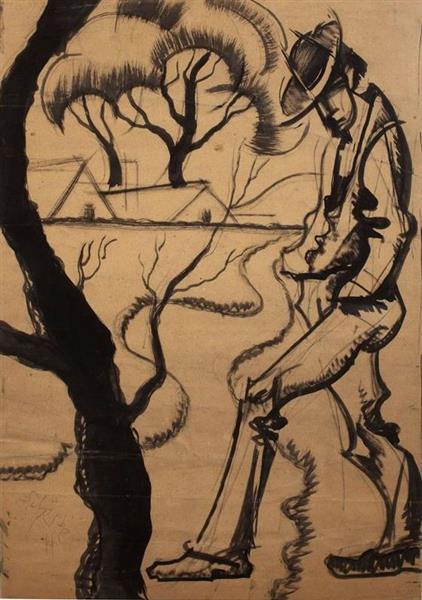Description
The work "Csavargó" by Hugó Scheiber is presented as a fascinating example of the dynamism and the expressiveness of the art of the early twentieth century. Scheiber, a Hungarian painter born in 1873, is known for his participation in avant -garde movements and for his ability to capture the essence of modern life through his works. "Csavargó" is one of those pieces that invite the viewer to stop and contemplate the multiple elements and layers that the artist has meticulously included in his composition.
At first glance, "Csavargó" shows a central figure that seems to be mired in a deep state of melancholy. The figure, probably a vagabond, is characterized by its angular lines and its emaciated appearance, which suggests a life of adversities and an existence on the margins of society. Scheiber masterfully handles the anatomy of his character, highlighting the sharp factions of the face and the skeletal forms of the body, which transmits a feeling of fragility and helplessness.
The use of color in paint is particularly remarkable. Scheiber opts for a palette of dark and terrible tones that reinforce the atmosphere of sadness and hopelessness. Brown and black tones dominate the composition, but there are also flashes of lighter colors that add depth and complexity to the image. These chromatic contrasts manage to create an impressive visual effect that captures and maintains the viewer's attention.
In terms of composition, "Csavargó" can be understood through its geometric shapes and its diagonal lines that guide the viewer's eye around the paint. The hunched posture and the introspective look of the central character create a visual flow that is both disturbing and fascinating. The sensation of movement and internal tension in the figure suggest a narrative of resistance and perseverance against a hard and oppressive reality.
Hugó Scheiber was influenced by various artistic currents of his time, including futurism and expressionism, and these influence are evident in "Csavargó." The painting encapsulates elements of both movements: the urgency of the present and intense emotional exploration. Scheiber was not only limited to representing reality with photographic accuracy, but also entered the internal world of his subject, seeking to reveal the underlying emotions and experiences that mold their existence.
Scheiber was an active member of the "Berlin Secession", an association of artists who promoted new forms of artistic expression and challenged traditional canons. Through this platform, Scheiber was able to experience and perfect its characteristic style, which is unmistakable in "CSavargó". The work not only reflects its technical domain, but also its commitment to exploring social and humanitarian themes.
By observing "CSavargó", one cannot avoid feeling a mixture of compassion and reflection. The painting is not only a representation of the figure of a vagabond, but also serves as a mirror for the human condition, reminding us of vulnerability and resilience inherent to it. Scheiber, with his sharp perception and his ability to evoke deep emotions, leaves us with a work that resonates far beyond his time.
KUADROS ©, a famous paint on your wall.
Hand-made oil painting reproductions, with the quality of professional artists and the distinctive seal of KUADROS ©.
Art reproduction service with satisfaction guarantee. If you are not completely satisfied with the replica of your painting, we refund your money 100%.

